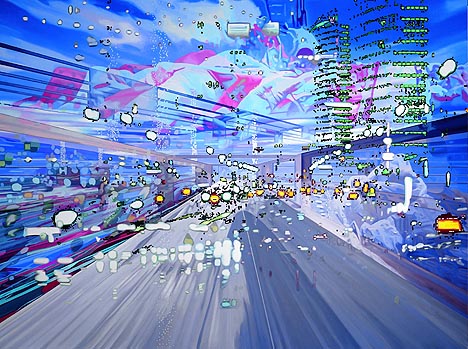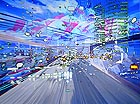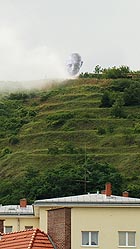
translated and summarized by: Liz Wollner-Grandville,
English summary January 18 - 24
Haus am Waldsee: Corinne Wasmuht: Supracity
Fathomless traditions
If one perceives paintings as a user interface, one could end up being faced with the user’s personal circumstances. Today’s user is familiar with motion pictures and equipment that links him to these, independent of his/her location. While the speed between the locations has increased, the length of stay has decreased.
Being able to create this spatially dispersed effect on a flat surface can be regarded as highly user-minded, and Corinne Wasmuht’s merit mainly constitutes itself through the invention of a visual effect, which allows both the amplification of human access and regardless of the location. “Pathfinder” (243x243, two-part, oil on wood, 2002) deals with superimposed and interlocked levels. A second path towers over of a central-perspective street view leading into the picture’s interior. Hazy pixel-like skyscraper facades are recognizable whose bases remain vague.
Numerous light blotches remind of metropolitan traffic motion. A reddish-blue mountain landscape emerges in the background, but its accessibility seems questionable – actually it is a failed attempt to take a picture of the Mars' surface, and the camera’s own parachute was photographed instead. What is left are impressions of speed and forlornness; weather does not exist, nor does daylight - if it weren’t for its format, this could just as well be a game console. The other two large format paintings displayed on the lower floor of the Haus am Waldsee also confront the viewer with a fractal world experience. If something like hopelessness of Modernism exists, the viewer is taken in and validated – as far as the disembodiment of those who are only discernible through the careless arrangement of their clothes’ folds. In the upper rooms there are earlier works, in which the spatial fragmentation gradually develops, but doesn’t raise the immediate claim to put the viewer into this situation. “Microscopic Anatomy” (254x381, three-part, oil on wood, 1994) is a bird’s eye view onto a pastel coloured container-scheme landscape, which develops its own Dadaist thrust. The discrete setting of shadows and the meticulous elaboration create an effective contrast to the size of the painting. The catalogue describes Wasmuht’s work as having eliminated the hope of taking refuge, something which painting was able to mediate before the secession of Modernism (“broken mirror”, as Stephan Berg wrote). The place for utopias is exhausted – the non-location has been reached. Should we, now enlightened in this way, substitute homeland by a GPS?
By Gesche Heumann
Haus am Waldsee
14163 Berlin, Argentinische Allee 30, until 21.02.10
www.hausamwaldsee-berlin.de
Next venue of the exhibit:
March 11 – May 16, 2010
Kunsthalle Nürnberg
www.kunsthalle.nuernberg.de
Factory – Kunsthalle Krems: Leopold Kessler
Big Brother, where art thou?
The official patron saint of art theory was most probably never so brutally employed as by Leopold Kessler: for the project “Hofgang mit Foucault” (yard exercise with Foucault), installed at the Factory, the artist mounted a 5m portrait photo of the French philosopher on the Kremser Kreuzberg, which can be seen from the Stein prison yard. But only after Kessler befogs it with smoke does it catch the inmates’ attention. The artist constructs new axes of vision – and simultaneously points to the permanent surveillance of the prisoners.
At the Krems exhibition, surveillance seems to be Kessler’s number one topic: e.g. he (secretly) filmed the entrances of former worker’s apartments in Krakow, where guided tours take place to offer an insight into the days of everyday communist life – in a time in which one of the main elements was: permanent surveillance. As charming as the idea of this duplication at first seemed, the outcome was actually minimal. All one sees are men and women walking up a staircase, waiting for their guide, and then entering the apartments.
Much more exciting is Kessler’s work in which he quickly sways from the atmosphere depicting Slovakian industrial urbanity to that of Austrians dancing a Waltz. A camera installed at the border shows images of the city of Devinska, then sways across streets and some pastures - always from the same position - to the other side of the border and ends up on the terrace of Schloss Hof, where couples are shown waltzing. The smoothness with which these two stereotype and completely contrasting images are conveyed, makes them even more cliché-laden and contradictory – simple production, great effect.
By Nina Schedlmayer
Factory – Kunsthalle Krems
3504 Krems, Steiner Landstrasse , until 14.02.2010
www.kunsthalle.at
For the second time: Parisian program at Berlin-based galleries
Gallery week-end during the Berlin winter
No, it’s not a typo, it’s French. This is exactly the way the opening weekend of the Berlin-Paris gallery exchange presented itself – as a smaller, French version of the in the meantime well-established Berliner Gallery Weekends. Just like in May (but this time, French) collectors arrived, and like in May an event atmosphere dominated, and everyone tried to visit as many of the simultaneously ongoing gallery-openings as possible. Initiated by the French Embassy, this year’s exchange included 27 galleries (2009: 23), of which 10 already took part last year.
Among the newcomers is the Gallery neugerriemschneider, who lent its premises to kamel mennour for three weeks and appeared in a completely different light. kamel mennour presents works by Yona Friedman, in which the roof and the façade of a characteristic example of Berlin factory architecture is covered with chicken wire. “I found it so sad and therefore dressed it up”, said the Hungarian, who lives in Paris, describing the brick chimney, which he covered with aluminium wiring and colourful flags. This transforms the chimney into an example of the improvised, utopian architectural designs by the 86-year-old, represented by photo collages and sketches of downtown Berlin.
Interaction with space is also a constant in three positions presented by the Gallery Balice Hertling at the Kreuzberg subsidiary MD72 of the Gallery Neu: three full-size installations fit perfectly into the sugar-coated stucco rooms, which don’t permit an outside view, only the direct interaction with the conceptual-analytic works by Falke Pisano, Luca Frei and Isabelle Cornaro.
The art currently presented at the 13 Berlin-based galleries oftentimes modifies local viewing habits: some of the galleries have chosen a French partner whose program is fundamentally different than their own. Johann König displays furniture from the 1950’s designed by Mathieu Matégot for the first time in Berlin. Matégot was introduced to perforated sheet metal as a prisoner in Germany and later made it his trademark: he created chairs, tables and lamps out of the metal, which he named “rigitulle”. Again this year, the Gallery 1900-2000 transformed its rooms, designed by Mehdi Chouakri, into a venue for Modernism and shows Francis Picabia’s oeuvre.
Hardly recognizable is the exchange at Gregor Podnar’s gallery, who decided to go for a joint exhibit with schleicher+lange. Under the title “Ellipse/Eclipse Part I” five artists question our limited perception - which could be boosted with certain mechanisms - point to technique and simulation, but nevertheless seem to celebrate these, experiment with perspectives and dimensions and devote themselves to spatial and chronological intervals. Worthwhile seeing is the group exhibit “Black and light” by the Gallery Denise René, founded in 1944, offering a cross-section of the gallery program characterized by constructive, concrete and kinetic art and presenting one of Victor Vasarely’s pieces at the young gallery sommer & kohl.
The exhibitions are presented at the participating galleries for one to eight weeks and enable the gallery owners to introduce their artists to a new audience - without having to participate at a fair. While the main idea is to promote French artists, the public-private partnership allows the galleries to choose which artists they want to present to German art connoisseurs. As of January 29, the German galleries will display their works at the venues of their Parisian colleagues.
By Conny Becker
Opening times and addresses at:
www.berlin-paris.fr
Mehr Texte von translated and summarized by: Liz Wollner-Grandville


 Teilen
Teilen




